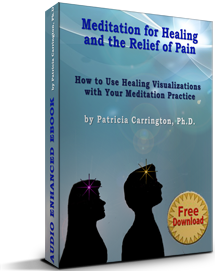Meditating to Reduce Stress
Combating Addiction with Meditation
, Ph.D.
Author of “The Book of Meditation”
Whether anxiety causes forms of addiction such as alcoholism or drug dependence is uncertain. These kinds of behavior are often strongly influenced by the stratum of society in which the person grows up, their early home situation, and perhaps certain inherited biological characteristics. If anxiety cannot be said to be the cause, however, it is certainly an effective trigger for severe bouts of addiction.
If meditation reduces anxiety, can it then help to control forms of addiction?
This question is worth exploring when we consider the magnitude of addiction in our society and the inadequacy of most of our present treatment methods to deal with it. In 1971 researchers Benson and Wallace sought to find out if meditation might have some effect on drug usage. They studied 1,862 TM teachers-in-training who had been practicing meditation for at least three months and often for longer, in an effort to find out how much marijuana, amphetamines, barbiturates, or hallucinogens (such as LSD) these people were still taking after their considerable amounts of meditation.1 On an anonymous questionnaire these teacher-trainees reported having all but eliminated drug abuse since commencing meditation, and even moderate use of such drugs was greatly reduced.
Whether this was due to meditation alone is hard to tell, however. TM teachers-in-training belong to a tight-knit community. They live together in residential training centers for many months, undergoing an intensive regime of meditation plus- instruction. While there, they experience strong group pressure to abandon drugs in favor of meditation; ‘successful meditators’ are thought of as being non-drug takers. However, even if the results Benson and Wallace found were due, in part at least, to a need to conform to group standards, this in itself tells us something important about how drug abuse might be controlled. It suggests that a meaningful social community can exert pressures which may effectively reduce drug intake.
In the six-month period before they started practicing meditation, about 80 percent of these prospective teachers had used marijuana, and of these, about 28 percent had been ‘heavy users’ (that is, were using the drug once a day or more). Six months after commencing meditation, only 37 percent of the teacher trainees were using marijuana and of these, only 6.5 percent were still heavy users. Among those trainees who had been meditating for twenty-one months or more, only 12 percent were still using marijuana and only one individual remained a heavy user. The decrease in the use of LSD was even more marked, and similar results were reported for other hallucinogens, narcotics, amphetamines and barbiturates.
These seemingly anti-addictive effects of meditation also extended to other areas. In the Benson–Wallace study, the percentage of teacher-trainees who drank hard liquor (either occasionally or often) before commencing meditation was 60 percent. This figure came down to 25 percent for the group who had been practicing TM for twenty-one months or more.
Much the same kinds of result were found for regular cigarette smokers: 48 percent of the teacher-trainees said they had smoked before starting meditation and 25 percent described themselves as having been ‘heavy users’ (that is, as having smoked one or more packs a day). After twenty-one months of meditating, these percentages had decreased to 16 percent who were still smoking and only 5–7 percent who were still ‘heavy users’.
What does this study tell us? Did these results occur because people who were more or less ready to stop taking drugs anyway
|
MEDITATION AUDIO LESSON
Dr. Patricia Carrington discusses how meditating is often beneficial in curbing addiction to cigarettes, alcohol, marijuana and other addictions, especially over time.
|
signed up to learn TM (this would leave hard-core drug users out of the picture)? Did the serious drug abusers among the meditators happen to dropout of meditation before the questionnaires were handed out, and so were not included in the study? Do drug abusers in general shy away from becoming TM teachers? Are the people who stay with the practice of meditation the type of people who would be more likely to become drug-free in the first place? In other words, does this study apply to a select group only or are its results typical of the general public?
There are as yet no answers to these questions, but some of my psychotherapist colleagues and I have seen impressive decreases in the use of drugs in patients who do not become TM teachers, and whom we have observed both before and after they learned to meditate. It was, in fact, clinical observations of this sort that led Dr Mohammad Shafii and his associates at the University of Michigan Medical Center to design a study which attempted to overcome some of the drawbacks of the Benson–-Wallace one.
The Michigan group felt it essential to have a ‘control group’, something which the Benson–Wallace study lacked. For this they chose people who used drugs but who were not meditators so that they could find out to what degree non-meditating people naturally cut down on drug usage over time. Because the Shafii group used this additional experimental safeguard, and because they used regular meditators, not TM teachers, as subjects, the results of their investigation are more informative.
The Shafii study showed a striking reduction in the amount of marijuana the TM group was still using after they had been meditating from one to thirty-nine months.2 The number of marijuana users was now reduced to nearly one-third the original number, while the figures for the control group stayed approximately the same, dipping only slightly.
As to regular cigarette smoking – a habit which when it is compulsively followed is classified as an addiction – 71 percent of those who had practiced meditation for more than two years reported a significant decrease in their use of cigarettes, and 57 percent had totally stopped smoking by that time, while cigarette usage for the control group remained almost the same.
Drinking of alcohol was affected too. Within the first six months after commencing meditation, 40 percent of the meditators who had been meditating regularly for more than two years had stopped drinking either beer or wine, while no control subjects had stopped. After three years of meditation the figures were even higher – 60 percent of the meditators had now stopped drinking beer and wine. In addition, 54 percent of this last group (as against 1 percent of the control group) had also stopped drinking hard liquor.
And newer studies support these findings. When Ann Royer studied the effects of meditation on cessation of smoking over a two-year period, 3 she found that 51 percent of those meditators who had adhered closely to their meditation program and been regular in their practice had successfully quit smoking by that time. By contrast, only 21 percent of those meditators who had only partially adhered to their meditation program and were irregular in their practice had quit the habit. Her results also suggested that the benefits of meditation were cumulative – the regular meditators’ smoking had continued to decline (or to cease altogether) over the twenty-four months of the study. In addition, once they stopped smoking, very few of the meditators ever resumed the habit.
Such studies as these suggest that meditation can be effective in preventing certain forms of addiction providing that a person is sufficiently motivated to continue meditating regularly for a long enough period of time. There seems to be a definite relationship between the amount of time a person has been meditating and the effectiveness of this practice in lessening drug consumption – the longer, the better.
Perhaps we have come to the point where we no longer need questionnaire studies which ask people what their drug usage was in the past. Instead we need more studies that follow a group from scratch, studying the same people before they start meditating and then again one or two years later. Although such studies are difficult and expensive to conduct, some have been done and the results of such longitudinal studies have been positive.4 There are also some interesting clinical observations which extend over time.
In my own practice I have observed five patients smoke less marijuana after commencing meditation, four patients reduce their use of alcohol, and another three stop smoking cigarettes with little, if any, nicotine withdrawal effects. This represents a large proportion of my patient population who were heavy drug users since only very few of my patients used drugs heavily to begin with. My clinical observations therefore seem quite consistent with the reduction percentages in the Shafii study.
Interestingly, I have seen one patient take up smoking marijuana for the first time after she resumed her regular practice of TM. She claimed that her freedom to use marijuana stemmed from the fact that meditation made her feel less guilty and she could now allow herself to experiment. Her behavior in this respect was part of a more general change. She had been a rigidly conventional woman, afraid of being spontaneous in any way. Now she was branching out into new activities in many areas of her life. She did not, however, develop an addiction to marijuana as a result of her easier attitude toward it. Her interest in it seemed to level off and eventually subsided, and at no point was her use of the drug more than a very occasional one.
A questionnaire survey on meditation and drug abuse conducted by Dr Leon Otis has also indicated that a very small number of the meditators questioned (6 percent) reported that they increased drug use after commencing meditation, although the majority (68 percent of those who had been meditating for less than two years) reported a sharp decrease in the use of drugs.5 It seems, however, that any increase in drug use with meditation, when and if it occurs, is sufficiently rare to be of minor significance compared to the pronounced trend toward decreased use of drugs with meditation.*
* Unfortunately Otis was not able to obtain information on how extensive these drug increases were when they occurred, which specific drugs were involved, whether the increases resulted in use or abuse of the drugs, or the role that the drug increase may have played in these people’s overall emotional adjustment.
1. H. Benson and R. K. Wallace, ‘Decreased Drug Abuse with Transcendental Meditation: A Study of 1862 Subjects’, Congressional Record, 92nd Congress, 1st session, June 1971, Serial 92–1.
2. M. Shafii, ‘Smoking Following Meditation’ (unpublished paper, University of Michigan Medical Center, Ann Arbor, Mich., 1973); M. Shafii, R. Lavely and R. Jaffe, ‘Meditation and Marijuana’, American Journal of Psychiatry, 131 (1974), pp. 60–63; M. Shafil, R. Lavely and R. Jaffe, ‘Meditation and the Prevention of Drug Abuse’, American Journal of Psychiatry, 132 (1975), pp. 942–5.
3. A. Royer, ‘The Role of Transcendental Meditation Technique in Promoting Smoking Cessation: A Longitudinal Study’, Alcoholism Treatment Quarterly, 11 (1994), pp. 221–39.
4. P. Gelderloos, K. G. Walton, D. W. Orme-Johnson et al., ‘Effectiveness of the Transcendental Meditation Program in Preventing and Treating Substance Misuse: A Review’, International Journal of the Addictions, 26 (3) (1991), pp. 293–325.; C. N. Alexander, P. Robison and M. Rainforth, ‘Treating and Preventing Alcohol, Nicotine, and Drug Abuse Through Transcendental Meditation: A Review and Statistical Meta-Analysis.’, Alcoholism Treatment Quarterly, 11 (1–2) (1994), pp. 13–87.
5. L. S. Otis, ‘The Psychobiology of Meditation: Some Psychological Changes’ (paper presented at the Annual Meeting of the American Psychological Association, Montreal, 1973).
Dr. Patricia Carrington's award winning meditation technique CSM (Clinically Standardized Meditation) is a clinically sensitive meditation method developed by the Medical Department of New York Telephone Company and used by numerous medical institutions, organizations, and individuals worldwide. For information click here.





